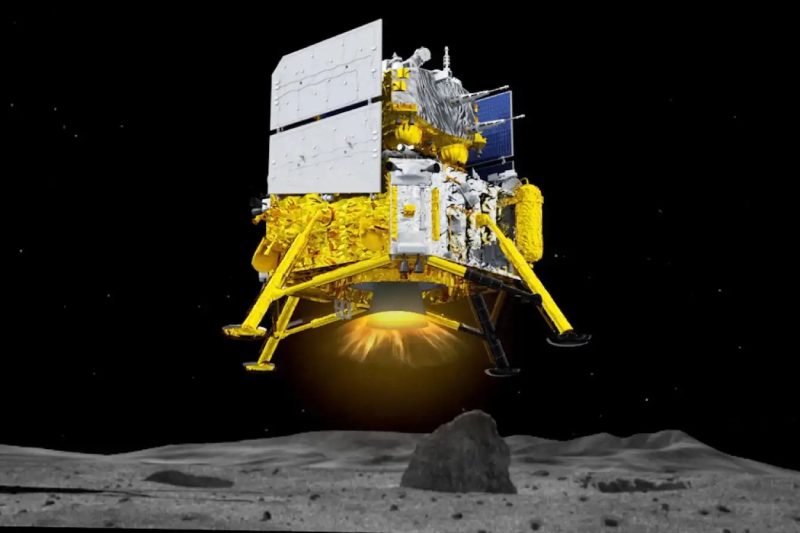The Chang’e-6 spacecraft from China is traveling to Earth to deliver samples that were gathered on the moon’s far side.
Around June 21, the Chang’e-6 service module most likely started its engines in preparation for a trans-Earth injection. The spacecraft is currently in the last part of its intricate 53-day journey, which includes a landing, sample, ascent, and docking on the moon. The special samples will be delivered from the service module into a reentry capsule just before the spacecraft arrives at Earth on June 25.
Regarding any maneuvers to remove the spacecraft from lunar orbit and return it to Earth, the China National Space Administration (CNSA) has not released any information. Nonetheless, amateur radio and optical investigations reveal that the Chang’e-6 spacecraft is traveling towards Earth.
Evidence of Chang’e-6’s activity comes from radio tracking by people and organizations like Scott Tilley and AMSAT-DL, as well as observations and data supplied by astronomer Bill Gray and others.
The reentry capsule is scheduled to land at Siziwang Banner, Inner Mongolia, on June 25 during a window that opens for 30 minutes at 1:41 a.m. Eastern (0541 UTC). The data is based on notifications of airspace closures. The CNSA has not disclosed the precise timeframes of mission events beforehand.
Before entering Earth’s atmosphere again, the reentry capsule will initially skip off of it in order to dissipate part of the energy of a high-velocity return from the moon.
The materials’ retrieval will enable in-depth investigation into the composition and history of the moon’s far side. The gathered data may offer hints regarding the early solar system’s history as well as an explanation for why the near and far sides differ so greatly.
Mission checkpoints
Chang’e-6 left Wenchang on May 3 and entered lunar orbit less than five days later, riding atop a Long March 5 rocket. On June 1, the lander-ascent vehicle combination touched down in the Apollo crater located in the enormous South Pole-Aitken basin at 41.6385°S, 206.0148°E.
About 49 hours later, the ascent vehicle of the mission took off carrying up to 2,000 grams of material collected by a scoop and drill. On June 6, the ascender landed in lunar orbit with the Chang’e-6 service module. After docking, the mission sample container independently moved to the reentry capsule.
A few days later, amateur radio tracking showed that the ascender deorbited into the moon. Regarding the ascender’s fate, the CNSA has not released a statement, but this would be in line with Chang’e-5 mission protocol from 2020.
On the far side of the moon, mission operations were made easier by the Queqiao-2 relay satellite. Launched before Chang’e-6, the spacecraft enables communication from the far side of the moon, which is never facing Earth since Earth’s gravity slows down the moon’s spin.
After the ascender’s launch, NASA Administrator Bill Nelson commended China for the mission’s advancement.
Josef Aschbacher, the head of the European Space Agency, also congratulated CNSA. He also mentioned how well China and ESA worked together on the Chang’e-6 mission.
This comprises the NILS (Negative Ions on Lunar Surface) instrument’s successful data collection as well as the ground station support provided by ESA during the first stages of the mission and the return to Earth. However, there may be an end in sight to China’s and ESA’s lunar cooperation.
Past Chang’e-6
The Chang’e 6 lander was discovered by NASA’s Lunar Reconnaissance Orbiter (LRO) on the edge of an eroding crater inside Apollo crater. On June 7, following the ascent vehicle’s launch of sample-collecting equipment into lunar orbit, LRO took images of the lander.
It was only the second landing on the far side of the moon. It takes place after the Chang’e-4 lander and rover mission landing in 2019. Chang’e-6 was made possible by that trip and the Chang’e-5 nearside sample return.
The Chang’e-6 service will probably start its engines when the reentry module is released in order to prevent reentry. The spacecraft might then be launched on a longer mission, contingent on propellant availability. After stopping by Sun-Earth Lagrange point 1, the Chang’e-5 orbiter went back to the moon to experiment with a far-off retrograde orbit. Once more, outside parties monitored Chang’e-5’s prolonged operations.
Chang’e-7, a multi-spacecraft, will be China’s next lunar mission, scheduled for 2026. Then, in or around 2028, comes the Chang’e-8 in-situ resource utilization and technology test mission.
These are referred to as the International Lunar Research Station (ILRS) predecessor missions, led by China. ILRS will be built by super heavy-lift launches in the early 2030s. Numerous nations and institutions have committed to the project.
Prior to this, China wants to send two astronauts to the moon by the year 2030.
